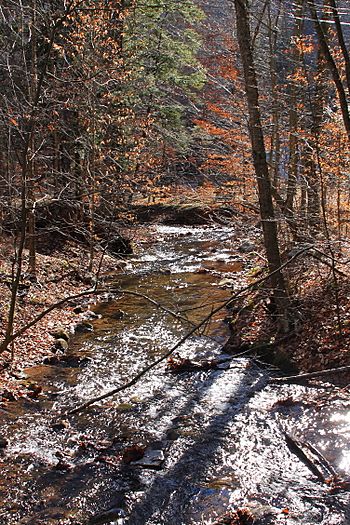Bloody Run (West Branch Fishing Creek tributary) facts for kids
Quick facts for kids Bloody Run |
|
|---|---|

Bloody Run in its lower reaches
|
|
| Physical characteristics | |
| Main source | plateau in Davidson Township, Sullivan County, Pennsylvania 2,280–2,300 feet (690–700 m) |
| River mouth | West Branch Fishing Creek in Davidson Township, Sullivan County, Pennsylvania 1,227 ft (374 m) 41°18′17″N 76°25′11″W / 41.3046°N 76.4196°W |
| Length | 2.9 mi (4.7 km) |
| Basin features | |
| Progression | West Branch Fishing Creek → Fishing Creek → Susquehanna River → Chesapeake Bay |
| Basin size | 1.30 sq mi (3.4 km2) |
Bloody Run is a small stream, or tributary, located in Sullivan County, Pennsylvania, in the United States. It flows into West Branch Fishing Creek. The stream is about 2.9 miles (4.7 km) long. It runs through an area called Davidson Township.
The land around Bloody Run has different types of rock and soil. The stream is a special place for water creatures. It is known as a High-Quality Coldwater Fishery. This means its water is clean and cold enough for certain fish and other aquatic life to thrive.
Contents
Where Does Bloody Run Flow?
Bloody Run starts in a valley on a high, flat area called a plateau. This is in Davidson Township. At first, it flows towards the south-southeast. Then, it turns to flow south-southwest.
After a short distance, the stream turns east-southeast. Its valley gets deeper here. It then flows south-southeast and then straight south for about two miles (three kilometers). The valley continues to get deeper along this path.
Finally, the stream leaves its deep valley. It turns east-southeast for a short distance. Here, it flows in the valley of West Branch Fishing Creek. This is where Bloody Run joins West Branch Fishing Creek. It meets the West Branch about 4.36 miles (7.02 km) before the West Branch reaches its own mouth.
The Land Around Bloody Run
The land around Bloody Run has interesting features. Near where Bloody Run meets West Branch Fishing Creek, the elevation is about 1,227 feet (374 m) above sea level. Where the stream begins, its source, the elevation is much higher. It's between 2,280 and 2,300 feet (690 and 700 m) above sea level.
You can find riffles in Bloody Run. These are shallow, rocky parts of the stream where the water flows quickly.
The ground around the stream has different types of soil and rock. In the lower parts of Bloody Run's valley, there is a type of soil left behind by glaciers. This is called Wisconsinan Bouldery Till. In the upper parts of the stream, there's another type of glacial soil called Wisconsinan Till. In the middle parts of the stream and on the edges of its valley, the ground is made of bedrock. This bedrock is mostly shale and sandstone.
Bloody Run's Home Area
The area that collects water for Bloody Run is called its watershed. This watershed covers an area of about 1.30 square miles (3.4 km2). The entire stream is located within the United States Geological Survey map area known as Elk Grove.
Bloody Run is part of the very beginning, or headwaters, of the larger Fishing Creek watershed. A small road crosses over the stream.
The Pennsylvania Department of Environmental Protection has given Bloody Run a special designation. It is meant for use by aquatic life. This means the stream meets high standards for supporting fish and other water creatures.
The Story Behind the Name
Bloody Run was officially added to the Geographic Names Information System on August 2, 1979. This system helps keep track of place names.
A concrete slab bridge was built over Bloody Run in 1937. This bridge is about 0.7 miles (1.1 km) west of a town called Elk Grove. It is 21.0 feet (6.4 m) long and is part of State Route 2003. In 1934, a special work camp called the Civilian Conservation Corps opened nearby. It was about 5 miles (8.0 km) west of the village of Central. This camp was located on West Branch Fishing Creek, between Bloody Run and another stream called Painter Run.
The name "Bloody Run" comes from an old story. Legend says that in the late 1700s, a hunter named John "Hunter John" McHenry killed seven deer near this stream in just one day. The stream was named Bloody Run to remember this event.
Fish and Friends in Bloody Run
Bloody Run is a very important stream for wildlife. It is officially called a High-Quality Coldwater Fishery. This means it has excellent, cold, clean water that is perfect for many types of fish and other water animals.
Scientists have found tiny creatures called larvae of a specific insect species, Palaeagapetus celsus, living near the stream. This shows that the stream's environment is healthy and supports a variety of life.

